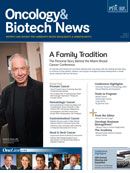Lenalidomide Improves Outcomes in Asymptomatic High-Risk Smoldering and Newly Diagnosed Myeloma
Continuous treatment with lenalidomide given early prolonged the time to progression, compared with no treatment in patients with high-risk, asymptomatic, smoldering, multiple myeloma.
Two different studies presented at the 53rd Annual ASH meeting showed good results with lenalidomide (Revlimid) given as induction therapy followed by continuous maintenance therapy. One study was in patients with high-risk smoldering myeloma and the second study was in newly diagnosed transplant-ineligible patients.
Continuous treatment with lenalidomide given early prolonged the time to progression, compared with no treatment in patients with high-risk, asymptomatic, smoldering, multiple myeloma, according to results of a phase III, randomized, multicenter, open-label study.
Observation alone is the current standard of care for smoldering multiple myeloma. Lenalidomide is approved for treatment of multiple myeloma in combination with dexamethasone in patients with at least 1 prior line of therapy. Use of lenalidomide plus dexamethasone in high-risk smoldering multiple myeloma is considered investigational.
The lead author on the study was Maria- Victoria Mateos, MD, PhD, Hospital Clinico Universitario, Salamanca, Spain. There were 119 evaluable high-risk patients. A total of 57 patients were randomized to lenalidomide (lenalidomide 25 mg/day on days 1-21 of a 28-day cycle) and dexamethasone (20 mg on days 1-4 and 12-15 of a 28-day cycle) for nine 4-week cycles, and then continued treatment with lenalidomide at a lower dose (10 mg/day on days 1-21 of a 28-day cycle) until disease progression; 62 patients were randomized to no treatment. High risk was defined by the presence of both >10% plasma cells in the bone marrow and serum monoclonal component >30 g/L, or if only 1 of these was present, a proportion of aberrant plasma cells within the bone marrow compartment by immunophenotyping of 95% plus immunoparesis.
At baseline, both groups were well balanced for demographic and disease characteristics. During induction, overall response rate (ORR) was 81%; of these 56% were partial response (PR), 11% very good PR, 7% complete response, and 7% stringent complete response.
At a median follow-up of 22 months, 9 of 57 patients (15%) in the treatment arm progressed to symptomatic disease; 14 patients progressed during continued treatment, but with the addition of dexamethasone, 10 were able to achieve disease control. In the treatment abstention arm, 37 of 61 patients (59%) progressed to active multiple myeloma.
At the time of ASH, median time to progression (TTP) had not yet been reached in the active treatment arm and was 23 months in the treatment abstention arm (P <.0001). Of the 37 patients in the abstention arm who developed disease progression, 20 had bone lesions as a symptom of multiple myeloma.
Three-year overall survival (OS) was 93% for those in the continuous lenalidomide arm versus 76% for the abstention arm (P = .04).
Grade 3 adverse events during induction therapy included asthenia (7%), diarrhea (4%), infection (2%), anemia (2%), and skin rash (2%). No grade 4 adverse events were reported.
Secondary primary malignancies (SPMs) were identified in 3 patients in the treatment arm. One patient developed polycythemia vera JAK2- positive on treatment, but he was JAK2-positive at enrollment. The other 2 SPMs occurred in prostate cancer patients with a previous history of prostate enlargement and elevated prostate-specific antigen.
Newly Diagnosed Multiple Myeloma, Transplant-Ineligible
Interim analysis of a separate randomized, double-blind, phase III study (study MM-015) of patients with newly diagnosed multiple myeloma ineligible for transplant found that continuous lenalidomide treatment improved PFS with a trend toward improved OS compared with no continuous lenalidomide. Lenalidomide is investigational in this setting.
Antonio Palumbo, MD, chief of the Myeloma Unit, University of Torino, Italy, was the lead author of the MM-015 study. The study included 459 patients who were randomized in a 1:1 ratio to: lenalidomide in combination with melphalan and prednisone followed by continuous lenalidomide alone (MPR-R), lenalidomide in combination with melphalan and prednisone followed by placebo (MPR), and placebo in combination with melphalan and prednisone followed by placebo (MP).
In patients aged 65 to 75 years, median PFS for MPR-R was 31 months versus 12 months in the MP arm (P <.001). Continuous lenalidomide achieved a 70% reduction in risk of progression versus MP in this group of patients. A trend toward improved OS was seen with MPR-R versus MP; 4-year OS was 69% for MPR-R versus 58% with MP.
Induction with MPR alone achieved a PFS benefit of 15 months versus 12 months for MP (P = .006).
Safety with maintenance lenalidomide was acceptable, with no evidence of cumulative toxicity. The most frequent grade 4 hematologic adverse event during maintenance was thrombocytopenia (4% for MPR-R vs 3% for MPR), anemia (3% vs 1%, respectively), and neutropenia (1% vs 0%, respectively). The most frequent nonhematologic grade 3 or 4 adverse events were infections (5% for MPR-R vs 3% for MPR), bone pain (5% vs 1%, respectively), and fatigue (3% vs 1%, respectively).
SPMs found during induction and maintenance occurred in 12 of 150 patients in the MPRR arm, 10 of 152 patients in of the MPR arm, and 4 of 153 patients of the MP arm. These rates are below the expected rates in myeloma, said Palumbo.
Mateos M-V, López-Corral L, Hernández M, et al. Smoldering multiple myeloma at high-risk of progression to symptomatic disease: a phase III, randomized, multicenter trial based on lenalidomide-dexamethasone as induction therapy followed by maintenance therapy with lenalidomide alone versus no treatment. Blood. (ASH Annual Meeting Abstracts) 2011;118(21, abstr 991).
Palumbo A, Adam Z, Kropff M, et al. A phase III study evaluating the efficacy and safety of lenalidomide combined with melphalan and prednisone followed by continuous lenalidomide maintenance in patients ≥ 65 years with newly diagnosed multiple myeloma: updated results for patients aged 65-75 years enrolled in MM-015. Blood. (ASH Annual Meeting Abstracts) 2011;118(21, abstr 475).




